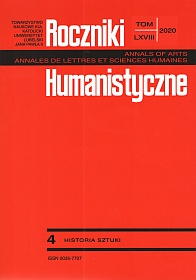Strategia państwowej autoprezentacji: sztuka ZSRS w Warszawie 1933 r.
The strategy of state self-presentation: the USSR art in Warsaw in 1933
Author(s): Irena KossowskaSubject(s): Fine Arts / Performing Arts, Visual Arts, History of Art
Published by: Towarzystwo Naukowe KUL & Katolicki Uniwersytet Lubelski Jana Pawła II
Keywords: Soviet art; socialist realism; propaganda; communism; painting; sculpture; graphic arts; neoclassicism; neorealism; postimpressionism
Summary/Abstract: The article analyses the critical reception of the Soviet art exhibition, which was organised at the Warsaw Institute of Art Propaganda in March 1933. The exhibition was in line with the tendency, which intensified in the 1930s, to highlight the cultural specificity of individual nation states through appropriately arranged exhibitions of native art, which travelled around Europe. The Warsaw exhibition of contemporary art of the USRR, brought from the 1932 Venice Biennale Internazionale d’Arte, can also be seen as an attempt to improve mutual relations between the Second Republic of Poland and the USSR in the context of the non-aggression pact signed on 25 July 1932. The proposal to show the exhibition to the Polish audience came from Boris Nikolayev, representing the All-Union Society for Cultural Relations with Foreign Countries, which was in fact an instrument of communist propaganda. The Warsaw exhibition enjoyed great interest among the audience. It was expected to present revolutionary, radically avant-garde art, coupled with the social and political goals of the Bolshevik revolution. Instead, the exhibition displayed proletarian art, which glorified the victorious communist system in a broadly conceived realistic convention. Most critics assessed the exhibition negatively, seeing it as a propaganda showcase of the USSR, not an all-inclusive representation of the Soviet art scene. For reviewers supporting the avant-garde, it was striking to see a break with the principles of revolutionary aesthetics. For commentators sympathising with neoclassicism, neorealism or colourism, the political profiling of the topics of the artworks on display was glaring. However, a general consensus was reached regarding the low artistic quality of the presented material. Commentators were looking for a style understood as an idiosyncratic unity of form and theme that would express the essence of the new political system of the USSR. The best testimony to the fact that they had not found such a style was Konrad Winkler’s conclusion: „The Lenin of the Soviet art has not yet been born”.
Journal: Roczniki Humanistyczne
- Issue Year: 68/2020
- Issue No: 4
- Page Range: 205-235
- Page Count: 31
- Language: Polish

